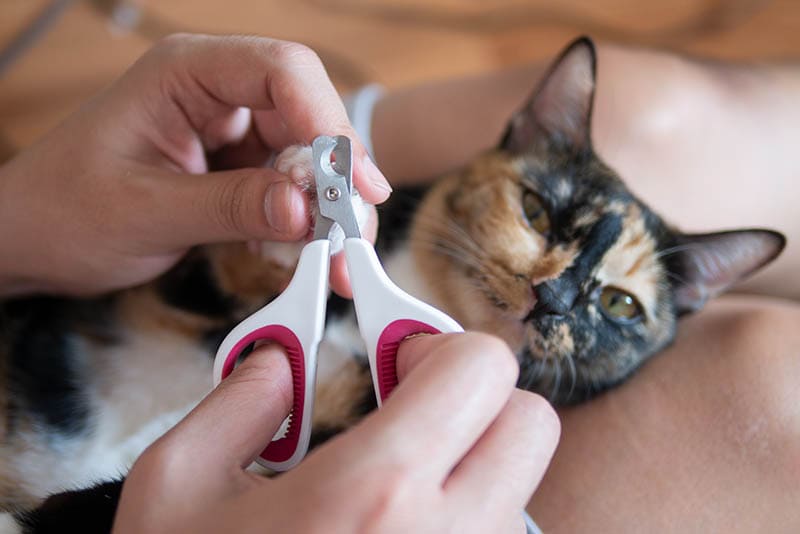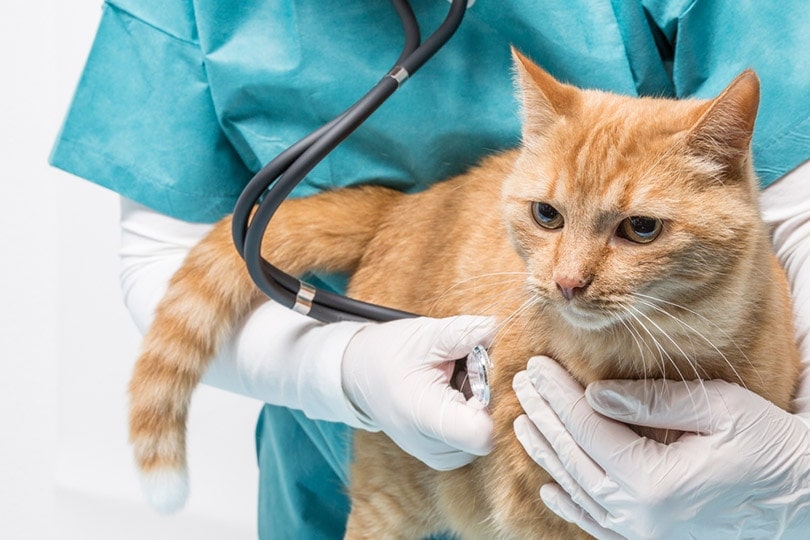Signs of Gingivitis in Cats: Vet-Verified Facts & Care Tips
Updated on
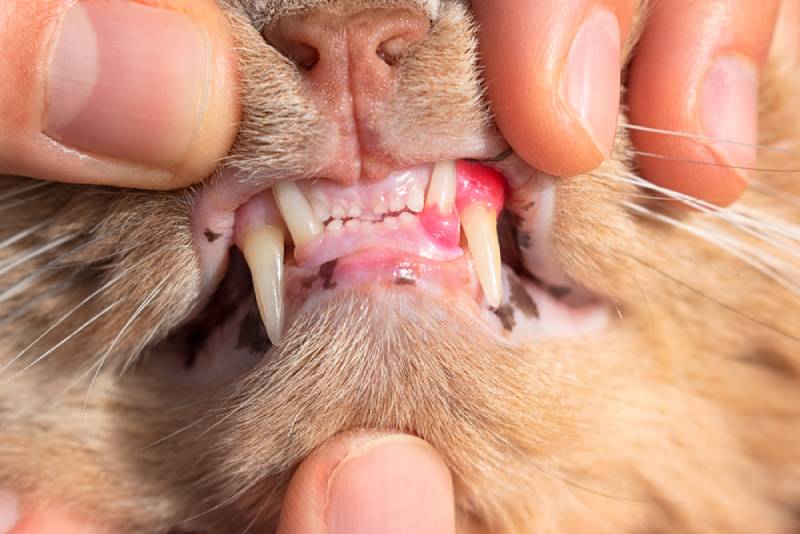
Cats are curious creatures that spend the entire day roaming around the house. You will often find them playing with toys and chewing household items. To maintain your cat’s optimal health, you must take them to a vet to diagnose common dental issues, especially gingivitis.
Gingivitis is a common oral disease in cats that involves inflammation, pain, and even bleeding from the gums. While the condition starts with mild changes, it can progress and become a serious health issue if not addressed correctly and in time.
This guide discusses the causes, signs, treatment, and tips for caring for a cat with gingivitis. So, let’s get started.
What Is Gingivitis?
Gingivitis is inflammation of the gums1. It’s normally diagnosed in cats from 3 to 4 years of age, but it can appear in younger cats, too. It starts because of plaque build-up in the cat’s mouth.
Plaque is a transparent-to-whitish film composed of a mixture of bacteria and other substances that adheres to the cat’s teeth. If plaque is not removed regularly, it can build up and migrate toward deeper tissues, often to a small pocket between the tooth and the gum (subgingival region) where the cat’s immune system will try to fight it off. The plaque will also harden and become tartar (calculus).
As a result of plaque accumulation over time, the pet’s gums become inflamed, red, painful, and sensitive, and they may even bleed. Gingivitis is the initial stage of periodontal disease, which involves disease of the gums and the tissues that support the teeth (alveolar bone, periodontal ligament, and cementum). It is considered advanced gum disease, but these terms are sometimes used interchangeably.
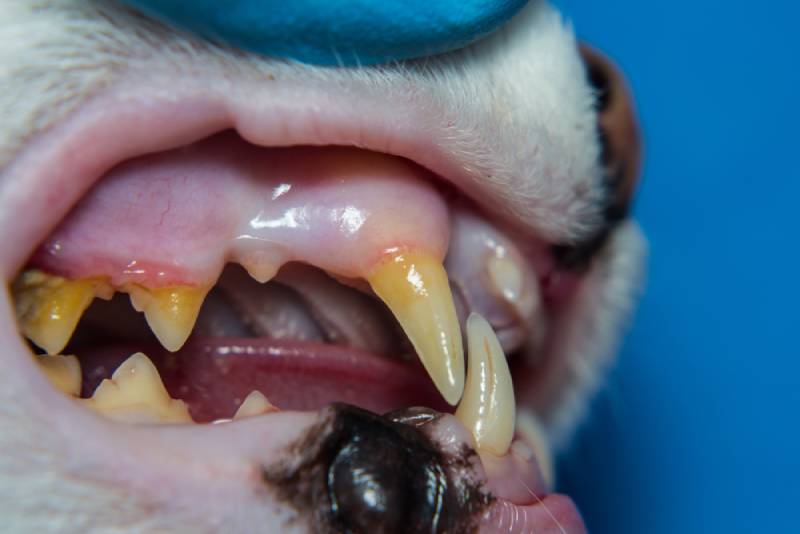
What Are the Signs of Gingivitis?
Swelling, redness, and bleeding gums are the main signs of gingivitis in cats. It also causes severe pain for the pet. Always keep in mind that the key to preventing gingivitis in cats is helping to reduce dental plaque buildup. Don’t wait until the gums are red and swollen to start looking after your cat’s mouth.
Here are the signs of gingivitis you should look for:
- Pain around the face
- Excessive drooling
- Bad breath
- Pawing at the mouth
- Chewing on one side
- Dropping food while eating
- Preference for wet food
- Difficulty eating or drinking
- Bleeding from the gums or bloody saliva
- Dirty front paws
- Reduced appetite
- Yowling or crying at the time of eating or drinking
- Weight loss
Some cats may show a few signs of gingivitis, while others display all the above indications. Inspecting your cat’s mouth is challenging, and cats are masters at hiding signs of illness. For these reasons, it’s vital to take your pet to a professional vet for regular check-ups.
What Are the Causes of Gingivitis in Cats?
Plaque accumulation in a cat’s mouth is a gradual process that develops with time. It can be reversible if caught early enough. However, if left untreated, it will accumulate and progress to a more complicated and painful condition. The price of the treatment will also be considerably higher.
Dental disease can affect cats of any age and varies in severity. Several factors affect the development of disease including:
- Infections. Many infectious diseases, such as feline immunodeficiency virus (FIV) and feline leukemia virus (FeLV), are associated with gingivitis in cats.
- Broken or Fractured Teeth.Trauma to your cat’s teeth can cause abnormal positioning or pulp exposure. This will cause varying degrees of dental disease.
- Abnormal Tooth Alignment. Teeth that are positioned abnormally in the mouth are more likely to accumulate plaque and tartar.
- Genetics. Some cats seem to be more predisposed to developing dental disease than others.
- Juvenile-Onset Gingivitis. Cats may suffer from this condition when their permanent teeth are erupting and they are losing their baby teeth. It causes redness and inflammation of the gums, along with bad breath. It should improve within a few weeks, but if your feline friend is showing any signs of discomfort, speak to your vet for advice.
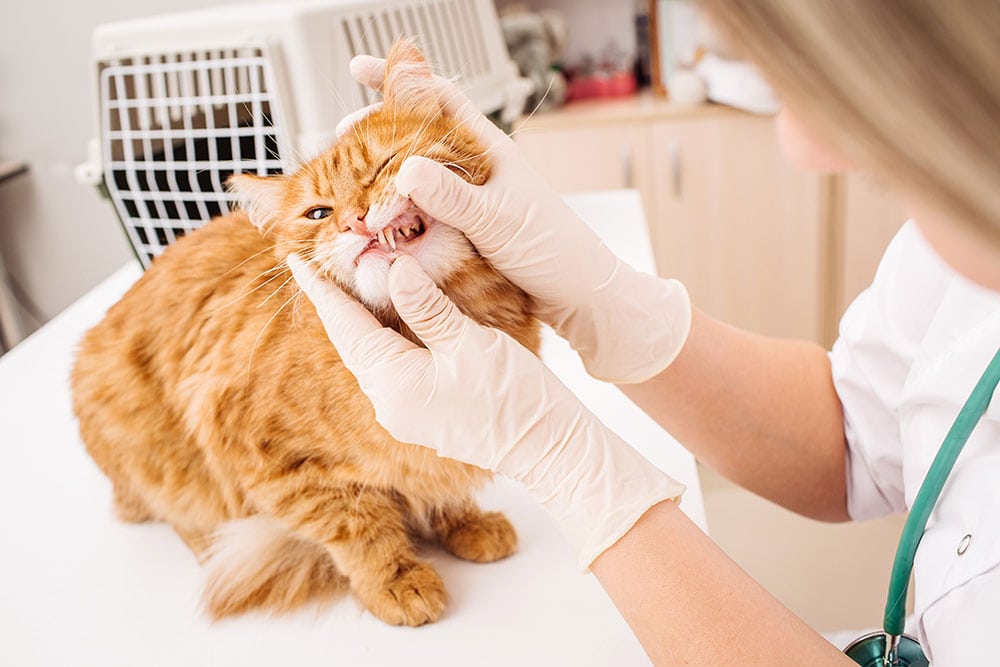
How Is Gingivitis Diagnosed in Cats?
Cats instinctively mask their pain, which is why they may show mild to no signs of gingivitis, even in extreme oral discomfort. Your cat may act normally, eat their food, and remain active even while suffering from intense dental pain. Once the inflammation and pain are treated and resolved, owners realize that their cat is back to the way they were!
Looking into your cat’s mouth and gums is not the easiest task, and you may not be able to identify the subtle changes that your veterinarian might see. Therefore, taking your cat to the vet for regular check-ups and routine yearly exams is important. Doing so will help the vet diagnose and address any dental disease, such as gingivitis, in cats. Depending on the diagnosis, the vet will develop a treatment plan for your cat.
How Is Gingivitis Treated in Cats?
The typical gingivitis treatment plan consists of removing plaque build-up and dental calculus from the pet’s teeth. Depending on the degree of dental disease, if the tooth support structures have been damaged, your vet may also extract your cat’s affected teeth. Before doing so, your vet may take X-rays of your cat’s mouth since most parts of the teeth can’t be seen externally (like an iceberg floating in the sea).
After a thorough cleaning done by your vet (normally called dental scale and polish), your vet will explain how to take care of your cat’s teeth in the future to avoid or minimize further problems.
As a responsible cat owner, you must ask your doctor how to clean your cat’s teeth. They will give you the appointment schedule along with a detailed care plan for your pet’s betterment.
Top 4 Tips for Caring for a Cat With Gingivitis
Prevention is always better than cure, especially when speaking about dental health. It is also less painful than the treatment. So, to avoid discomfort and pain, you must take care of your cat and take preventive steps from an early age. Apart from visiting your vet regularly, here are some practical tips to help you care for your cat:
1. Get Them Used to You Touching Their Mouth
Some cats don’t like humans touching their mouths. So, you can try getting them used to it by placing some dental treats, wet food, or cat toothpaste onto your finger. Let your cat lick it off your finger and then progressively start touching and rubbing your cat’s gums and teeth while they are licking the food.
Once your cat becomes familiar with you touching their mouth and rubbing their gums, you can introduce the toothbrush. The best way to start brushing your cat’s teeth is to do it for approximately 20 to 30 seconds per side. You may be able to do it for longer over time. Be sure to reward them afterward.
2. Use Cat-Friendly Toothpaste and Toothbrush
You should only brush your cat’s teeth with cat-specific toothpaste and toothbrushes. They’re specially designed for your cat’s small teeth and do not include the ingredients found in human toothpaste that are toxic to cats. Introduce your cat to toothbrushing gradually but regularly using positive reinforcement so that it becomes a nice habit.
Try leaving snacks close to toothpaste and the toothbrush. Alternatively, you can put a few dabs of toothpaste to let your cat lick them off and become accustomed to the taste.
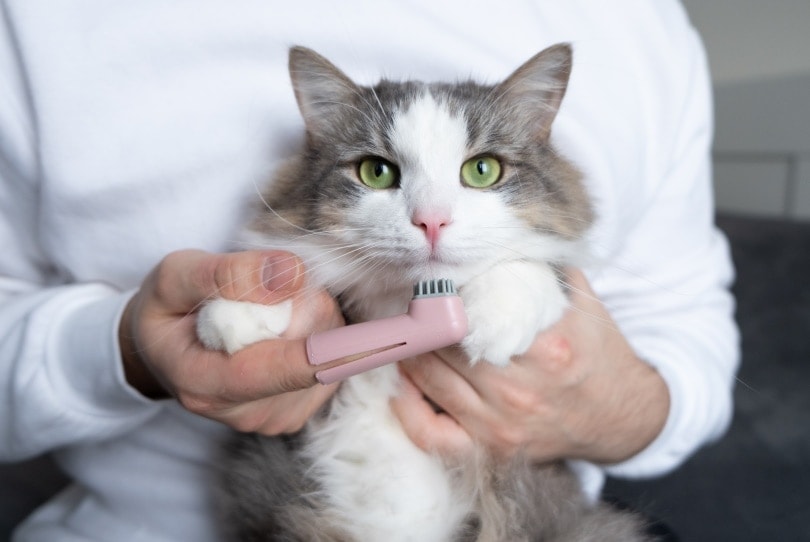
3. Use Plaque-Minimizing Products
You can use water additives and oral rinses to reduce plaque buildup. Your vet may recommend Veterinary Oral Health Council (VOHC)-approved products for this purpose. You can also get your cat dental toys and treats that can help keep them entertained and improve their oral health at the same time.
If your cat is already suffering from gingivitis, there might be times when they find it harder to eat dry food. In that case, moist meals are recommended instead.
4. Plan a Balanced Diet
You must also plan a balanced diet for your cat’s overall health. It will keep your pet’s health at their best, helping them recover from gingivitis. Always consult a professional nutritionist about developing the best diet for your pet’s condition. If your cat is suffering from gingivitis and their appetite is reduced, it is a good idea to have very nutritious recovery food in the cupboard. This will ensure that they consume all of the necessary nutrients in a smaller portion while the treatment from your vet takes effect.
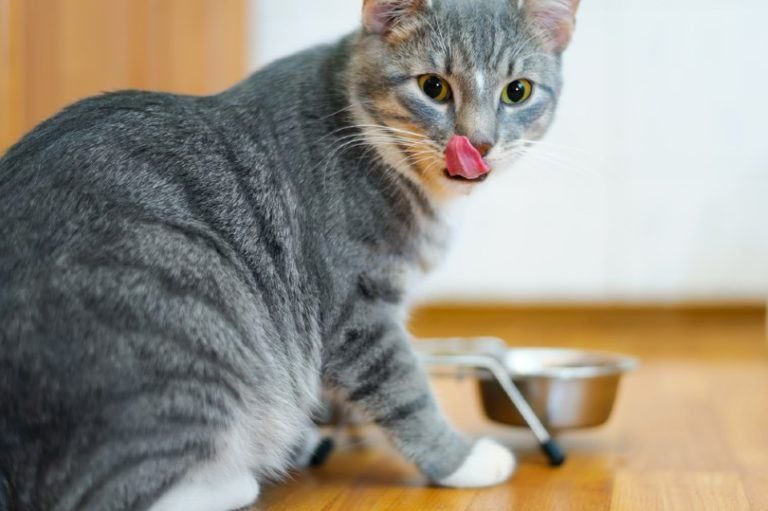
Frequently Asked Questions (FAQ)
Below are some questions related to gingivitis in cats that responsible pet owners ask about:
How Do I Know if My Cat Has Gingivitis?
You can identify your cat’s gingivitis by spotting signs like red or swollen gums, bad breath, difficulty eating and playing with toys, changes in appetite, blood from their mouth, blood-stained water in their drinking bowl, drooling, and pawing at their mouth. These are the primary signs of gingivitis in cats.
How Do You Take Care of a Cat With Gingivitis?
Always follow your vet’s plan. You can take care of a cat with mild gingivitis by brushing their teeth to remove the plaque and prevent build-up. Depending on your cat’s degree of inflammation, your vet may also recommend medications like antibiotics, anti-inflammatories, and painkillers and will advise you on products to use in order to minimize the condition and prevent further inflammation.
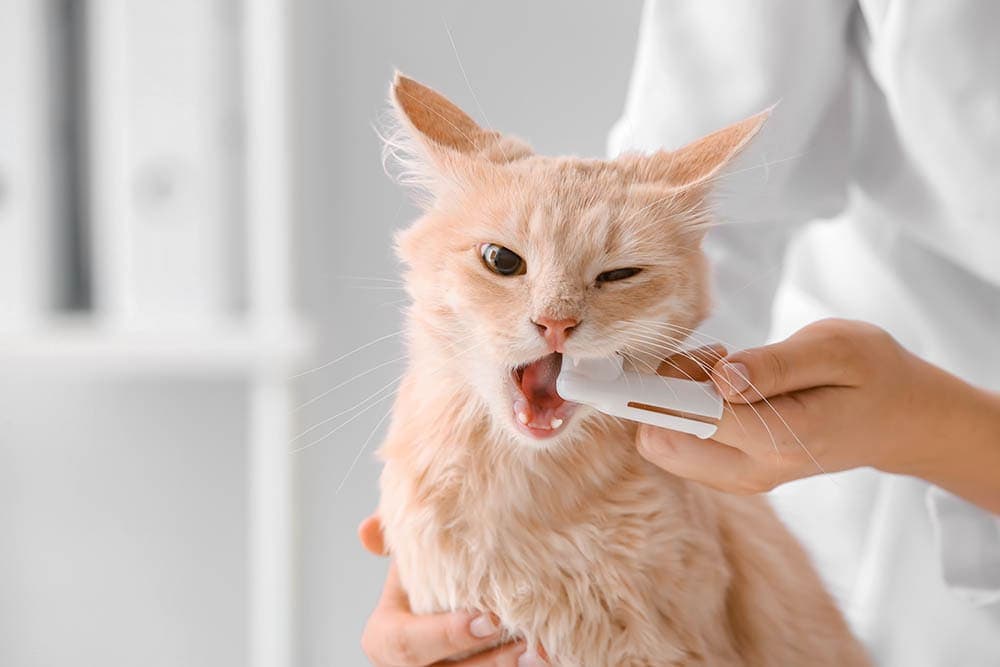
Should I Take My Cat to the Vet for Gingivitis?
Of course. Severe gingivitis can make brushing quite painful for your cat. Thus, taking your cat to a vet is recommended before trying any home remedy.
What Do Vets Do for Gingivitis in Cats?
After examining your cat, the vet may perform X-rays of your cat’s mouth and do a thorough cleaning. It is possible that your vet may extract some teeth if they are diseased; otherwise, they would cause chronic problems for your cat.
Final Thoughts
Gingivitis is commonly found in cats of all ages and varies widely in severity. It involves swelling, redness, and even bleeding of the cat’s gums due to excessive plaque build-up and tartar, causing inflammation. The condition can be very painful for your cat, impacting their daily life and feeding habits.
It is essential to take your cat to a vet for regular check ups and especially as soon as you observe the signs of gingivitis in your pet. These include drooling, blood around the mouth, chewing on one side of the mouth, bad breath, changes in appetite, difficulty eating and drinking, and pawing at their mouth. The vet will examine your cat and determine the best plan of action.
Featured Image Credit: Yaya Photos, Shutterstock


